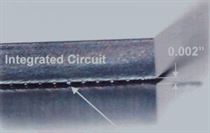What Is a 'Wetting Index' and What Does It Tell Me About a Solvent and Cleaning Results?
MicroCare vapor degreasing products are the best choice for precision cleaning of difficult shapes and awkward pieces. The reason for this success is the very low surface tension, high density and low viscosity of the different fluids:
- A low surface tension means the solvent can get into tight spaces more easily than solvents with high surface tensions (like aqueous systems);
- A heavy solvent literally can float away contamination that other types of cleaning agents cannot move;
- A solvent with low viscosity flows in and around objects more effectively than solvents with high viscosity (think molasses, or maple syrup).

This BGA chip on a printed circuit board has a 2 mil stand-off from the substrate. Modern solvents can clean beneath this component but aqueous cleaning systems will struggle to get into such tight spaces
A clever way to understand all these different measurements is to combine the three most critical factors into a single index. MicroCare recommends combining the density of the solvent, the viscosity of the solvent and the surface tension into an index score. We call this the wetting index. With the wetting index, the higher the score the better the cleaning.
The formula for computing a wetting index is:
(Density x 1000)
divided by
(Surface Tension x Viscosity)
In particular, the wetting index is a superior predictor when comparing particulate cleaners. It’s simply a better yardstick to use when selecting a solvent for applications in which the object is not to dissolve the contamination but to float it away. Here’s how the numbers rack up:
Not-In-Kind Benchmarks
| Brand Name or Description | Liquid Density (kg/liter) | Surface Tension (dyne/cm) | Viscosity (cP) | Wetting Index |
|---|---|---|---|---|
| Water | 1.00 | 73 | 1.00 | 14 |
| IPA Alcohol* | 0.79 | 22 | 2.40 | 15 |
First Generation
| Brand Name or Description | Liquid Density (kg/liter) | Surface Tension (dyne/cm) | Viscosity (cP) | Wetting Index |
|---|---|---|---|---|
| Trichloroethylene (TCE or Trike) | 1.46 | 29 | 0.58 | 87 |
| Perchloroethylene (PCE or Perc) | 1.62 | 35 | 0.88 | 53 |
| Freon™ TF† | 1.57 | 17 | 0.70 | 132 |
Second Generation
| Brand Name or Description | Liquid Density (kg/liter) | Surface Tension (dyne/cm) | Viscosity (cP) | Wetting Index |
|---|---|---|---|---|
| Genesolv® 2004† | 1.23 | 19 | 0.43 | 151 |
| AK-225† | 1.55 | 16 | 0.59 | 164 |
| Bromothane™ (nPB) | 1.35 | 26 | 0.49 | 106 |
Third Generation
| Brand Name or Description | Liquid Density (kg/liter) | Surface Tension (dyne/cm) | Viscosity (cP) | Wetting Index |
|---|---|---|---|---|
| Novec® 71DA | 1.33 | 16 | 0.45 | 185 |
| Vertrel™ XF | 1.58 | 14 | 0.67 | 168 |
| MicroCare™ HDS | 1.32 | 195 | 0.57 | 122 |
| Vertrel™ SFR | 1.28 | 21 | 0.42 | 145 |
Fourth Generation
| Brand Name or Description | Liquid Density (kg/liter) | Surface Tension (dyne/cm) | Viscosity (cP) | Wetting Index |
|---|---|---|---|---|
| Opteon™ Sion/SF79 | 1.28 | 21 | 0.42 | 145 |
| Solstice® PF | 1.26 | 13 | 0.45 | 215 |
| AE-3000 | 1.35 | 16 | 0.34 | 248 |
Disclaimer
* Indicates a flammable cleaning fluid; this usually is an ingredient in an azeotropic blend.
† Indicates a Class 1 or Class 2 ozone-depleting solvent; no longer used by environmentally responsible companies and countries; included here merely for completeness.
So here’s the short answer: when it comes to tough cleaning problems, the huge family of MicroCare cleaners are a great choice. They are great replacements for ozone-depleting solvents such as CFC-113, 1,1,1-trichloroethane, HCFC-141b and HCFC-225, as well as high-global-warming solvents such as perfluorocarbons (PFCs).
